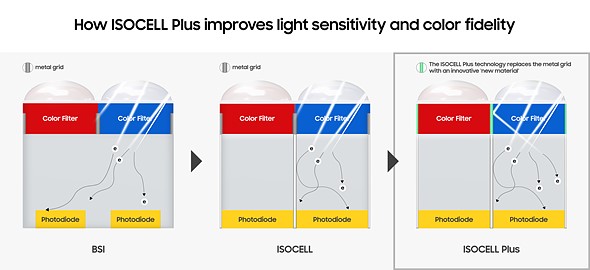Samsung ISOCell:
It uses physical barriers between neighboring pixels to reduce color crosstalk and expand the capability to capture light, compared to conventional backside-illuminated (BSI) image sensors.
Now the Korean company has launched 'ISOCELL Plus' which has been developed in cooperation with FujiFilm. It replaces the metal grid at the front of the pixels with a new 'mystery' material, providing even better separation between pixels.
This material reduces reflections and light absorption by the barriers between pixels, leading to increased light sensitivity of up to 15% and better color fidelity. According to Samsung the technology allows for the design of sensors with 0.8µm and smaller-sized pixels without a loss in performance. This is 1/3rd the size of the pixels in a typical 1"-type sensor and should allow smartphone sensors with a resolution of 20MP and higher.
“We value our strategic relationship with Samsung and would like to congratulate on the completion of the ISOCELL Plus development,” said Naoto Yanagihara, corporate vice president of Fujifilm. “This development is a remarkable milestone for us as it marks the first commercialization of our new material. Through continuous cooperation with Samsung, we anticipate to bring more meaningful innovation to mobile cameras.”
In combination with other new mobile imaging technologies, such as multi-frame stacking and multi-sensor camera modules, ISOCELL Plus should allow for the design of smartphone cameras with even better low light performance than we're seeing in current models.
Samsung will be showcasing the new sensors at Mobile World Congress Shanghai come end of June, but for now there is no word on when to expect the new technology in a production smartphone.
It was introduced in 2013
It uses physical barriers between neighboring pixels to reduce color crosstalk and expand the capability to capture light, compared to conventional backside-illuminated (BSI) image sensors.
Now the Korean company has launched 'ISOCELL Plus' which has been developed in cooperation with FujiFilm. It replaces the metal grid at the front of the pixels with a new 'mystery' material, providing even better separation between pixels.
This material reduces reflections and light absorption by the barriers between pixels, leading to increased light sensitivity of up to 15% and better color fidelity. According to Samsung the technology allows for the design of sensors with 0.8µm and smaller-sized pixels without a loss in performance. This is 1/3rd the size of the pixels in a typical 1"-type sensor and should allow smartphone sensors with a resolution of 20MP and higher.
“We value our strategic relationship with Samsung and would like to congratulate on the completion of the ISOCELL Plus development,” said Naoto Yanagihara, corporate vice president of Fujifilm. “This development is a remarkable milestone for us as it marks the first commercialization of our new material. Through continuous cooperation with Samsung, we anticipate to bring more meaningful innovation to mobile cameras.”
In combination with other new mobile imaging technologies, such as multi-frame stacking and multi-sensor camera modules, ISOCELL Plus should allow for the design of smartphone cameras with even better low light performance than we're seeing in current models.
Samsung will be showcasing the new sensors at Mobile World Congress Shanghai come end of June, but for now there is no word on when to expect the new technology in a production smartphone.
It was introduced in 2013

留言
張貼留言